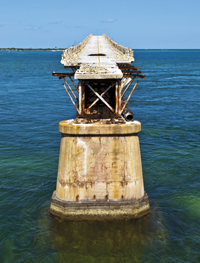With the rise of the digital age, are engineers forgetting the value of learning from the successes – and failures – of those who have gone before?
By Henry Petroski
We do not expect our bridges to drop out from beneath us, and the engineers who design them take great pains to ensure that they do not. The surest way to obviate the failure of any structure is anticipating all the possible things that can go wrong and designing in defences against, and safe responses to, undesirable behaviour.

One way in which engineers are aided in thinking of everything that can go wrong with a bridge or any other designed structure or system is through their knowledge of past failures. This makes the engineer an historian of sorts, one who knows how his or her predecessors have sometimes struggled (and with fewer and less powerful analytical tools than the computers that can make things seem so easy today) to achieve success only to be disappointed by failure.
Even when Imhotep, the first engineer whose name we know, was designing pyramids in ancient Egypt, he surely relied upon the experiences of his predecessors to build better than they. His knowledge of their prior successful achievements was helpful in presenting benchmarks against which his improvements could be measured, but it was from their failures that he learned the most important thing an engineer can know – what not to do.
From ancient times well into the Renaissance, structures of all kinds were proportioned according to geometric rules. The design of larger and larger obelisks, cathedrals, and ships was based on prior experience with smaller versions that worked.
Failures taught that there were limits to the size of structures, but engineers did not then understand why this was the case.
A catalogue of failures
It was Galileo who made the observation that the success of a structure depended not only upon its geometry, but also upon the strength of its materials. He recognised that with an increase in size, a structure’s weight increases faster than its strength. This enabled him to explain why failures were occurring and to develop an analytical approach that became the foundation of rational structural engineering.
However, to meaningfully apply to a specific structure the analytical tools to which Galileo’s work gave rise, engineers have to know where and in what mode its failure can occur.
This is where a catalogue – no matter how formal or informal – of past failures is essential. Not being aware of just one potential failure mode can jeopardise an entire design effort, no matter how digitally sophisticated it might be. And, of course, it is past failures rather than past successes that provide this invaluable information.
No engineer today designing a long-span suspension bridge will likely neglect to consider the stability of its deck in the wind. The infamous 1940 collapse of the Tacoma Narrows Bridge, which was caught on film, remains a sobering reminder that even a massive steel structure can be destroyed by winds of only 42 miles per hour (68km/h).
Another infamous failure, the 1981 collapse of a pair of skybridges that killed 113 people in a Kansas City hotel, reminded engineers that a simple modification of a single design detail can change an entire system and so introduce into it a new mode of failure.
The embarrassing experience with London’s Millennium Bridge, which in 2000 had to be closed down due to excessive sideways motion just three days after opening, makes it unlikely than any engineer designing a footbridge today will forget that pedestrians exert lateral as well as vertical forces when they walk.
A catalogue of failures is as helpful as an engineer’s handbook for designing successful structures and systems. Without knowledge of past failures, designers are liable to make the same kinds of mistakes that have been made throughout history. Unfortunately, in an age when there is so much reliance upon computer-based methods in design, there can be a tendency to ignore or even dismiss both good and bad experiences that are not in the latest digital format.
Henry Petroski is the Aleksandar S. Vesic Professor of Civil Engineering and a professor of history at Duke University. He is the author of To Forgive Design: Understanding Failure
and, most recently, The House with Sixteen Handmade Doors: A Tale of Architectural Choice and Craftsmanship
.
This article originally appeared in Public Works Professional
, May–June 2014 edition.#International #Bridges #AssetManagement